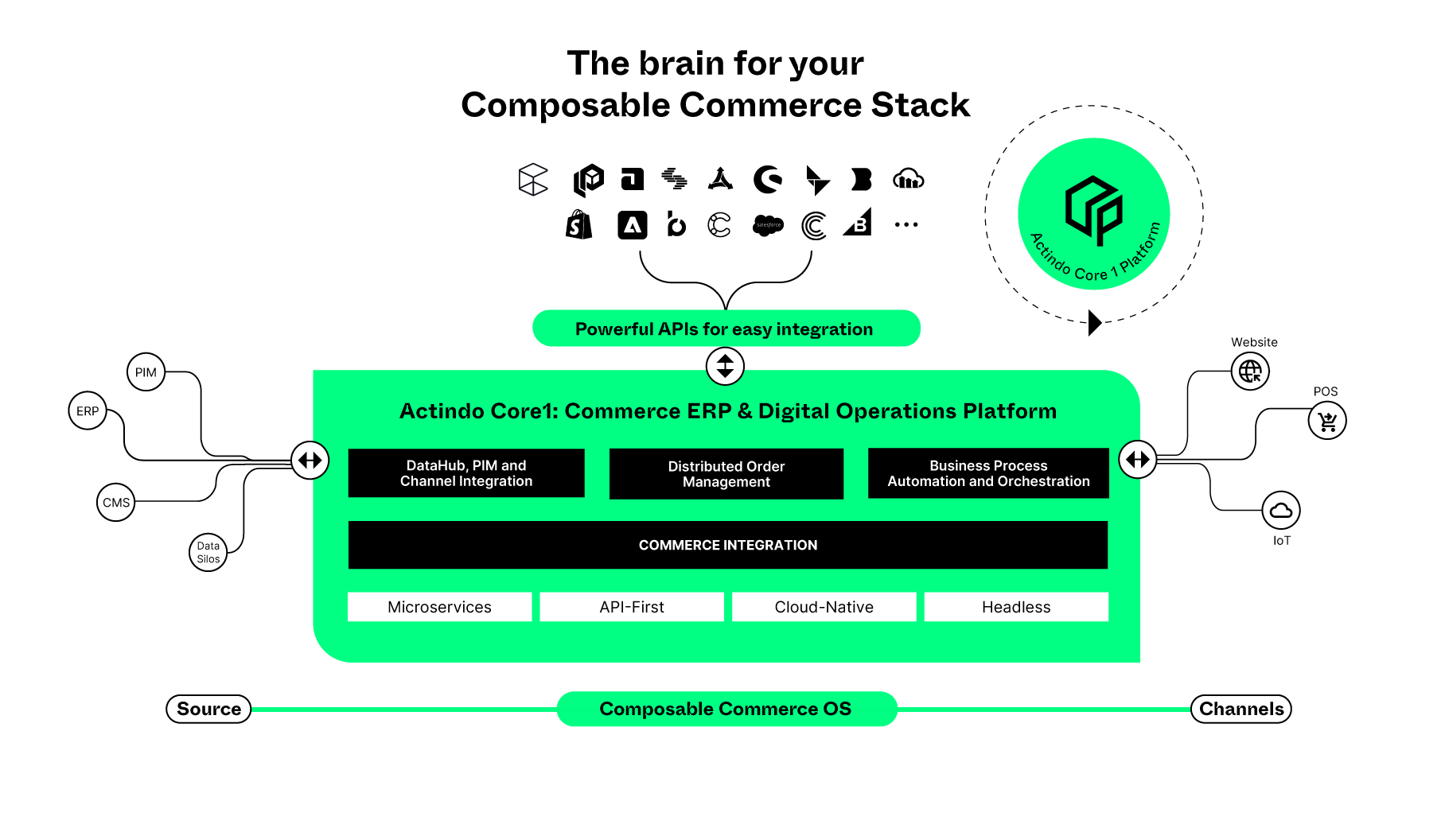3 Use Cases for Social Commerce with Actindo
We show how brands and retailers can sell effectively on TikTok, Instagram et al - while maintaining their profit margins and meeting customer...

Social commerce is growing fast globally, fueled by younger generations who prefer shopping directly through platforms like TikTok and Instagram.
How fast? Well, a 2022 study by Accenture found that it was growing three times as fast as “traditional” e-commerce, and sales would likely reach $1.2 trillion by 2025. Gen Z and Millennials are expected to account for 62% of that staggering sum.
Such bullish growth has already spurred Meta to partner up with Amazon in the US, where consumers can make in-app purchases on Facebook and Instagram. More retail platform partnerships are sure to follow.
Yet while there is undoubtedly much money to be made, the social commerce boom presents retailers with significant challenges. These range from order management to the creation of personalized post-purchase experiences, and more. Fundamentally, the challenge is how to tie together the various channels into a satisfying whole.
In this article, we’ll look at the key opportunities and challenges of social commerce, and how composable commerce standards like MACH can help brands, retailers and manufacturers navigate these waters.
Social commerce is defined as a shopping experience that takes place entirely on social media platforms, from product discovery to the checkout process and post-purchase experience.
These platforms have completely turned the customer journey on its head: users now discover new products on social media, research the item themselves, buy the item, interact with and engage with the brand, recommend the product to others and thus start the cycle all over again, creating a so-called "Infinite Loop".
On Instagram, over 130 million users click on shopping posts every month, and 46% of users have already made a purchase via the Instagram checkout. TikTok in particular attracts users with purchasing power: 55% of TikTok users have made a purchase after viewing a product or brand on the platform.
Yet these platforms are not only changing the way customers discover and buy products, but also how they interact with brands after the purchase. The post-purchase experience is more important than ever— and composable commerce offers limitless opportunities to personalize and enhance these experiences.
When it comes to social commerce, retailers are often faced with the challenge of a fragmented IT landscape. Maybe they use rigid, monolithic ERP systems that do not meet the requirements of modern social selling.
Or the software landscape is at the other end of the IT spectrum and consists of numerous isolated e-commerce applications that do not communicate with each other. In essence, it often boils down to a connectivity and data integration challenge.
A highly flexible commerce ERP based on MACH principles, such as Actindo Core1, creates a strong foundation for composable post-purchase experiences. With open API interfaces and a headless architecture, the modular commerce landscape ensures seamless data integration and synchronization across a variety of platforms and third-party systems.
This scalable and flexible infrastructure enables an extremely fast time-to-market of new applications to create personalized offers, content and services that match the requirements of social media sales. Which means your IT landscape can grow seamlessly with future requirements.
Composable post-purchase methods such as fast delivery, up-to-date delivery information and simple processing of shipments and returns have proven themselves in modern e-commerce.
However, on social media, it’s mainly behavior-based elements that influence brand results, such as sharing product reviews and experiences.
A study by Material on the global TikTok purchase path shows that one in four users writes a post about the product after purchase, highlights the brand in their content, shows the product or comments on a post by the brand.
These interactions are not only important for customer retention and new customer acquisition, but also provide valuable insights for companies to improve their products and services.
Which is why Actindo Core1 enables brands, retailers and manufacturers to gather these insights, and leverage a central cockpit to unify, orchestrate and automate all business process.
>> 3 Use Cases for Social Commerce with Actindo <<
As part of a composable commerce approach, retailers can implement the following post-purchase strategies to improve operational efficiencies and customer satisfaction:
1. Data and analytics as a foundation: Consolidated data is crucial in the context of social media post-purchase experience. Composable commerce ERPs like Actindo Core1 leverage data integration, process management and the scalability of a composable commerce approach to provide businesses with a personalized and responsive customer experience that adapts to customers' ever-changing trends and preferences. This data helps to create personalized offers and content based on customer preferences and behavior.
2. Gather customer feedback: How do you know if your customers have had a good experience after purchase? Via online surveys! With the right data at your fingertips, you can improve the buying experience and understand which features customers like best. TikTok provides advertising partners with Post Purchase Surveys that merchants can integrate into their e-commerce platform, and survey their customers directly after checkout to gain valuable insights into the customer's path to purchase.
3. User-generated content (UGC): Encouraging customers to share their experiences with products or services on platforms like TikTok is instrumental in improving the post-purchase experience. It increases customer satisfaction and promotes the 'Infinity Loop' for sales growth and customer loyalty.
4. Streamlined Process Orchestration: Actindo Core1 lets you leverage process orchestration on social media for efficient management of customer interactions. This strategy ensures timely and personalized responses, enhancing customer engagement. Automated workflows facilitate swift handling of inquiries, returns, and feedback, leading to more consistent and satisfying customer experiences post-purchase. Such efficiency not only improves resolution times but also aligns interactions with customer preferences, contributing to a stronger social media presence.
With Actindo Core1, you can create individual workflows and orchestrate business processes across all channels, including social media platforms, using powerful datahub capabilities:

5. Interactive post-purchase communication: Send personalized messages or exclusive offers based on your customers' previous interactions. For example, a user who has liked a product on Instagram could receive a personalized ad or even a direct message with more information or a special offer on that product.
6. Omnichannel communication: To improve the customer experience after the purchase, you should meet your customers on the channels they prefer to use. Composable commerce makes it easy to integrate the right omnichannel customer service tools that fit the needs of your business and your target audience. This allows you to offer customer support and order information across all channels, optimized for every device.
7. Adapt delivery information to social media: Your customers eagerly await news of their package after purchase. Chatbots can help to provide this info 24/7. Unbottled takes the extra step of adding an image to their tracking emails and encourages customers to share their experience on Instagram. This is a clever way to reach new customers and improve the post-purchase experience.
For brands venturing into social commerce, managing multiple channels, inventory, and orders can be a Herculean task. In a world where social channels are becoming the new storefronts, being equipped with the right tools is not just an advantage—it's a necessity.
Which is why renowned lifestyle brand Kapten & Son chose Actindo Core1 to connect their social commerce and influencer marketing activities, maintain real-time inventory accuracy and process orders efficiently across all channels:
All business processes are automated, orchestrated and customized with just a few clicks, and all data streams are consolidated and can be viewed in real time, so that the Kapten & Son operations team can work together collaboratively to make informed decisions.
After deploying Actindo Core1, Kapten & Son saw a 23% increase in customer care team productivity and streamlined their order processing, setting a new standard for operational efficiency in social commerce.
Retailers, brands and manufacturers shouldn’t underestimate the power of social media and the “Infinite Loop” for a successful post-purchase experience, especially with younger consumers.
Platforms like Instagram and TikTok offer a unique opportunity to engage customers post-purchase, personalize their experience and ultimately build brand loyalty.
Composable commerce plays a central role in this, as it provides companies with the flexibility and scalability needed to quickly adapt to ever-changing customer needs and market trends.
A powerful composable commerce ERP like Actindo Core1 is the ideal foundation to effectively address these challenges and create cohesive post-purchase experiences. Find out more:
>> Platform overview <<
We show how brands and retailers can sell effectively on TikTok, Instagram et al - while maintaining their profit margins and meeting customer...
Exclusive study for Actindo finds that German consumers prioritize clear, effective communication for their online orders - especially before...
Meet the essential ingredient for leveraging MACH tech to deliver unified experiences, using the fulfillment stack that’s right for you and your...